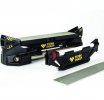- Joined
- Apr 9, 2022
- Messages
- 343
So i gifted a Tuff lite to a buddy that works construction. He let me know he needed it sharpened and I said heck yes, a challenge. My entire small collection is used so lightly as to rarely need more that stropping. So this is my first real attempt at recovering an edge. I do go with the 30 per side so as to hipefully get him a tougher edge with less chipping.
1. Worksharp field sharpener diamond course till past the chip, than fine.
2. Spyderco sharpmaker idohone stones course, then spyercos brown, then white fine.
3. Strop with green compound.
Any advice is appreciated, i feel like i was able to get past the chip, but my bevel is pretty uneven. It is sharp, so that is a plus. I imagine i will get another go at this in a couple months.
2 pre, 2 post pics:
1. Worksharp field sharpener diamond course till past the chip, than fine.
2. Spyderco sharpmaker idohone stones course, then spyercos brown, then white fine.
3. Strop with green compound.
Any advice is appreciated, i feel like i was able to get past the chip, but my bevel is pretty uneven. It is sharp, so that is a plus. I imagine i will get another go at this in a couple months.
2 pre, 2 post pics:

